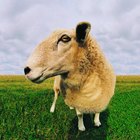A fable is a type of fictional tale, usually in the form of a short story that is intended to teach a moral lesson to its reader. Fables are fiction in the sense that the story told did not actually happen, although some fables may have been based on real events. Fables have entertained children around the globe for centuries, and each shares specific characteristics that make it a fable.
History
Aesop’s fables are among the most widely read and recited fables. No one knows who Aesop was, but some believe that he was a Greek slave living around 600 B.C. Like most fables, Aesop’s stories were most likely retellings of stories heard from a variety of sources. It is said that Aesop told such entertaining tales that he was given his freedom. His stories became so well loved by children that they traveled and survived by word of mouth until someone, at some point in history, finally started writing them down. They've since become beloved bedtime stories that are read to children all over the world. According to the Children’s Literature network, scholars have traced the origins of fables even further back than Aesop's time, all the way back to 1800 B.C.
Characters
The characters in fables are typically animals that can think, talk and behave like humans. Each story usually features two or three of these characters facing problems people face every day. Often fable characters are stereotypical, with human strengths and weaknesses. Examples of typical fable characters include a brave mouse, a wise owl or a cunning fox. By using simple characters, the fable removes the need for complex personalities, and this allows children to focus on its moral theme.
Structure
Like any other story, a fable consists of a beginning, a middle and an ending. Because most fables are intended for children, their structure is simple and straightforward. The beginning of a fable introduces the main characters, which usually includes a hero and a villain. The beginning also tells about a key event that leads to a conflict that the main character must overcome. In "The Tortoise and the Hare," the slow tortoise must win a race against the fast hare. When you reach the middle of a fable, you experience the main character’s struggle to resolve this conflict. For example, the tortoise patiently plods along, while the hare speeds past him. At the end, the main character is victorious. These three parts combine to teach children a moral lesson about everyday life. In the example of "The Tortoise and the Hare," the child learns that it is better to take your time, and that patience is a virtue.
Language
Fables are written using simple language, often with simple words and short sentences so they can be easily read and understood by children of all ages. They may be written as a poem, with rhyming verses, or using prose in the same manner as other stories. Using poetry helps to make the fable more entertaining and memorable for children. The dialogue within a fable often poses questions that are used to help the story along to its moral ending.
Moral Lesson
The primary element of fables is to teach children a lesson about seeing and overcoming their weaknesses. They're also sometimes used to poke fun at authority figures in a humorous way. The moral of a fable summarizes the story in a brief statement that is usually in the form of useful wisdom. For example, the moral of "The Emperor's New Clothes," a fable written by Hans Christian Andersen, is that honesty is the best policy.
Related Articles

Bible Games on Psalms for Kids

Valentine Bible Stories for Children

Preschool Activities for Teaching ...

Children's Activities for the Parable ...

Ideas for Lessons on Teaching a ...

Christian Sunday School Lessons About ...

Middle School Bible Games

Early Childhood Social Skills Needed to ...

Free Children's Bible Activities Grades ...

Children's Activities for Jeremiah ...

LDS Sunbeam Primary Activities

Children's Beatitude Activities

Sunday School Craft Ideas Showing God's ...

5 Tips for a Boston Family Vacation

What Is Fraternal Love?

Preschool Bible Crafts & Activities on ...

Sunday School Lessons for Teenagers

Empathy Training Activities

Children's Activities for Psalms 23

Positive and Negative Aspects of ...
References
Writer Bio
Renee Miller began writing professionally in 2008, contributing to websites and the "Community Press" newspaper. She is co-founder of On Fiction Writing, a website for writers. Miller holds a diploma in social services from Clarke College in Belleville, Ontario.